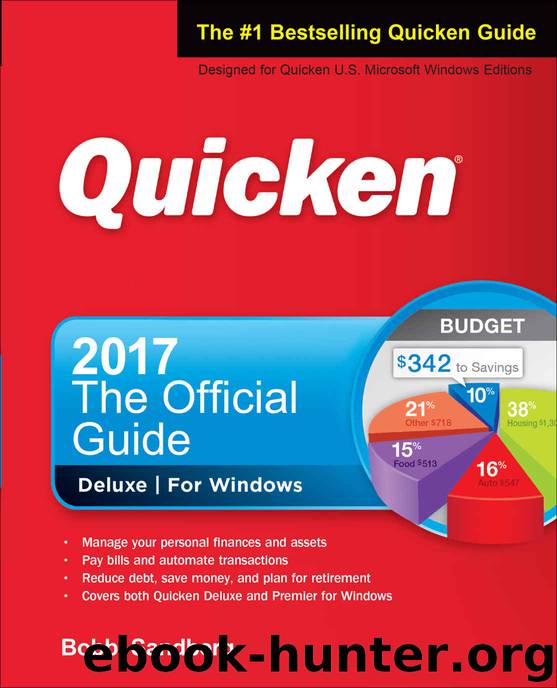Quicken 2017 The Official Guide (Quicken : the Official Guide) by Sandberg Bobbi

Author:Sandberg, Bobbi [Sandberg, Bobbi]
Language: eng
Format: epub
Publisher: McGraw-Hill Education
Published: 2017-03-10T05:00:00+00:00
If Quicken can’t find information about the security on the Internet, it displays a dialog enabling you to correct the ticker symbol, or add the security manually. If you made an error when entering the ticker symbol, you can enter the correct symbol in the Ticker Symbol text box and click Next to try looking it up on the Internet again. This security is automatically included in your Quicken Watch List when you add it in this manner.
If you select the Add Manually option, select a security type—Bond, CD, Emp. Stock Option, ESPP, Market Index, Mutual Fund, Other, Stock, or U.S. Savings Bond—and click Next. Another dialog appears, prompting you for additional information about the security, such as its asset class (for a stock), asset class mixture (for a mutual fund), and bond type and maturity and call dates (for a bond). Enter whatever information you have for the security, and click Done to add the security to the Security List.
EXPERIENCED USERS RECOMMEND
Quicken users often ask the Quicken Community how Quicken defines “asset class.” Strictly speaking, an asset class is a group of similar securities, such as equity instruments or stocks, income instruments such as bonds, and cash equivalents such as money market accounts. Within each asset class are categories. Quicken uses the shorthand name of “asset classes” to define types or categories of securities. When you enter “asset class” information in Quicken, you are categorizing the asset as one of several different asset “types”:
• Domestic Bonds These bonds are issued and traded in the currency of the country in which they are traded. That means they are not subject to fluctuations in currency exchange rates.
• Global Bonds These bonds are traded in any international market, either foreign or domestic. The same bond issue may be offered in several countries at the same time.
• Large Cap Stocks These securities are offered by large, publicly traded companies with a “market capitalization” of at least $10 billion. (Market capitalization is simply a generally accepted value of a company.) In Quicken, the cutoff between small cap and large cap is $4 billion.
• Small Cap Stocks Securities offered by a publicly traded firm with a market capitalization of between $200 to 300 million and $2 to 3 billion.
• International Stock These are securities sold by a company outside of the United States.
• Cash/Other/Unclassified Assets that do not fit one of the other classifications.
Download
This site does not store any files on its server. We only index and link to content provided by other sites. Please contact the content providers to delete copyright contents if any and email us, we'll remove relevant links or contents immediately.
Sass and Compass in Action by Wynn Netherland Nathan Weizenbaum Chris Eppstein Brandon Mathis(7915)
Supercharging Productivity with Trello by Brittany Joiner(7216)
Mastering Tableau 2023 - Fourth Edition by Marleen Meier(6991)
Inkscape by Example by István Szép(6844)
Secrets of the JavaScript Ninja by John Resig Bear Bibeault(6641)
Visualize Complex Processes with Microsoft Visio by David J Parker & Šenaj Lelić(6524)
Build Stunning Real-time VFX with Unreal Engine 5 by Hrishikesh Andurlekar(5553)
Design Made Easy with Inkscape by Christopher Rogers(4928)
Customizing Microsoft Teams by Gopi Kondameda(4473)
Business Intelligence Career Master Plan by Eduardo Chavez & Danny Moncada(4323)
Extending Microsoft Power Apps with Power Apps Component Framework by Danish Naglekar(4064)
Linux Device Driver Development Cookbook by Rodolfo Giometti(3991)
Salesforce Platform Enterprise Architecture - Fourth Edition by Andrew Fawcett(3945)
Pandas Cookbook by Theodore Petrou(3941)
The Tableau Workshop by Sumit Gupta Sylvester Pinto Shweta Sankhe-Savale JC Gillet and Kenneth Michael Cherven(3708)
Exploring Microsoft Excel's Hidden Treasures by David Ringstrom(3206)
TCP IP by Todd Lammle(3099)
Applied Predictive Modeling by Max Kuhn & Kjell Johnson(2986)
Drawing Shortcuts: Developing Quick Drawing Skills Using Today's Technology by Leggitt Jim(2960)
